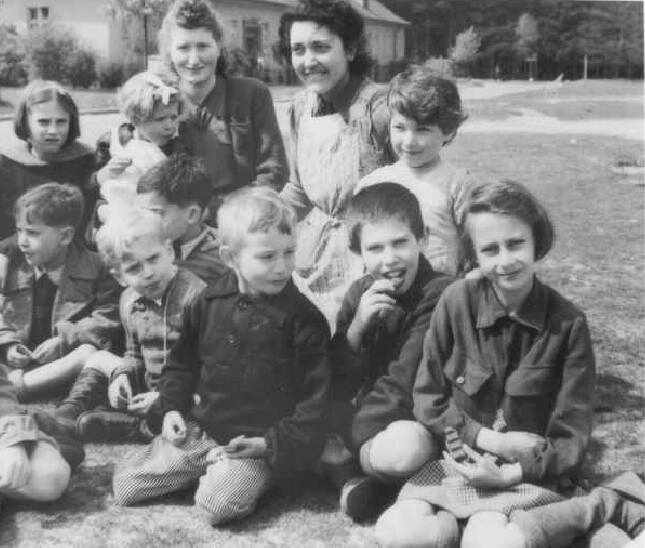
Bergen-Belsen Displaced Persons Camps

Figure 1.-- Here are Jewish children released from the Bergen-Belsen KZ Lager (Concentration Camp). But this may be a misunderstanding. The photograph was probably taken at the British DP Camp. The photograph was taken 5.9.45. (I think that means September 5, 1945.) Most of the children shown are orphans, their parents murdered by the Germans. The children look surprisingly healthy. Unfortunately we do not have their individual stories. Source: Acme News Press Photograph
|
|
As a result of the NAZI slave labor program, when the NAZIs surrendered (May 7, 1945) there were millions of foreign displaced persond (DPs) ers in the Reich from every country in Europe. Many were abused and mistreated and by the end of the war large number had persished. The Allies set up displaced persons camps to provide emergency assistance to the DPs as to help them return to their home countries. Some of the DP camps were established in former NAZI concentration camps. One of the most notable was the Jewish Camp set up in the former NAZI Bergen Belsen conentration camp.
DP Camp (July 1945)
Bergen-Belsen became the largest DP camp in Germany. The British set up the Bergen-Belsen DP camp (July 1945). The site chosen for the DP camp was a Wehrmacht camp near the infamous NAZI concentration camp. The British named the facility Camp Hohne. Many of the first DPs arriving at the camp were Bergen-Belsen survivors. They insisted on calling the DP camp Bergen-Belsen.
About 12,000 DPs were housed there.
Jewish Center Organized (November 1945)
The British responding to request from Jewish DPs, permitted them to set up a section of the Bergen-Belsen DP Camp as a separate Jewish facility. Thus was the only British camp where the Jews were allowed to do so. As a result, the Camp developed as a kind of center for Jewish organization and thought in the British occupation zone in Germany. The Jews at the camp emerged as the most vocal element of the “She'erit Ha-Peletah” (The Surviving Remnant). The Jewish section of Bergen-Belsen expanded to about 11,000 people (1946). Tension developed between the Jews and the British authorities. The major issue became Palestine. The British because of the difficuties prohibited more Jews from entering te Bergen-Belsen Camp (1946). The British also transferred the Camp to the United Nations Relief and Rehabilitation Agency (UNRRA) (March 1946).
The British under a League of Nations Mandate were administering Palestine. The NAZIs had not reached Palestine, the British stopped the Afrika Korps at El Alemain (July 1942). Zionist emigration to Palestine was eing resisted by the Palestinian Arabs and becoming an issue in other Aab countries. The British to placate the Arabs were attmpting to restrict Jewish emmigration.
Disputes with the British
Jewish survivors from the NAZI Bergen-Belsen Camp were especially vocal at the DP camp and helped organize the Camp politucally. Josef Rosensaft and Norbert Wollheim were especially prominent in persuing a range of political, social, and cultural aims, foremost among them was the right to emigrate to Palestine.
The Haganah (the clandestine Jewish Army in Palestine) infiltrated agents into the Camp and conducted secret military training exrercises (December 1947). The British prohibited open departures until after the Isrea was established and the Arab military intervention defeated (1949).
After years of supression and attrocity, Jewish family and cultural life flourished at the DP Camp. Numerous weddings took place daily. Several thousand children were born at the camp. The DPs founded a primary school for the surviving children (July 1945). Many of the children were from the special camps set up in the NAZI Bergen-Belsen Camp. At most NAZI concentration camps, the children were some of the first to be murdered. Bergen-Belsen was an excepton because the NAZIs were intending to exchange the Jews. After liberation, The primary school as part of the DP camp at its peak had 340 children (1948). A high school was also established (December 1945). Many of the teachers were soldiers from the Jewish Brigade (the Palestinian Jewish unit trained by the British). In addition a Kindergarten, orphanage, and a yeshiva (Jewish religious school) were organized. The orpanage was apparently named Hampsire Camp. The Organization for Rehabilitation through Training (ORT) set up vocational training schools.
Closing
Once the British allowed the DPs to freely leave the camp with restrictions on Palestine no longer in place, the Jews rapidly left (1949). Most went to Israel. Quite anumber also went to America and Canada. Few were left by mid-1950. The last DPs left the camp and it was closed (August 1951).
CIH -- Holocaust

Navigate the CIH Holocaust Section:
[Return to Main Bergen-Belsen Concentration Camp page]
[Return to Main displaced children page]
[Return to Main NAZI KZ camp list]
[About Us]
[Allies]
[Biographies]
[Children]
[Concentration camps]
[Countries]
[Decision]
[Denyers/Apologists]
[Displaced persons]
[Economics]
[Eisatzgruppen]
[Eugenics]
[German Jews]
[Ghettoes]
[Impact]
[Justice]
[Literature]
[Movies]
[NAZIs]
[Occupied Poland]
[Process]
[Propagada]
[Resistance]
[Restitution]
[Questions]
[SA]
[SS]
[Special situations]
[Targets]
[Wansee Conference]
[Return to the World War II]
[Return to Main Holocaust page]
[Return to the Main mass killing page]
[Return to CIH Home page]
Created: 5:24 PM 11/13/2006
Last updated: 12:19 PM 9/30/2017



